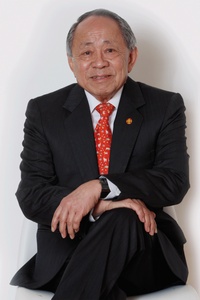Obituary: Ron Sang
Gina Hochstein pays tribute to a celebrated New Zealand architect, art collector and book publisher, whose award-winning career spanned more than five decades.

The life of the late Ron Sang was celebrated at St Michael’s Church, Remuera, on Saturday 19 June by family, friends and colleagues. The church was full, with standing room only and attendees dressed in a swathe of bright colour as Sang had wished.
Sang was more than a multi-award-winning architect; he was, also, an avid collector and patron of art, pottery and sculpture, a publisher, a photographer, a pillar of the Chinese community and, notably, a great cook. In 2000, he received the prestigious recognition of being named an Officer of the New Zealand Order of Merit for his contribution to architecture and the arts.
I first met Sang on the Brian Brake site when I was seven years old. My family lived next door in a modernist house from the late 1950s and my curiosity was welcomed. I believed he was designing and building me a fairy castle, which he happily confirmed. Eventually, my parents broke the news to me that this special cedar-clad dwelling was in fact for Brian Brake and Raymond Lau, who became dear friends of our family.
My personal recollections of meeting with him on many occasions and of his largesse are indicative of the many stories that have been told. His generous nature was given credence, as was his support for the arts and ease at building strong relationships. Clients and artists alike became firm friends. He wanted to understand their creative processes of making.
Sang was born in Fiji to Chinese immigrant parents and travelled to China to learn Cantonese in his formative years. His interest in architecture began in the third form, when he was back in Fiji. In 1957, Sang began his architectural degree at the University of Auckland. His first commission was in 1965, the Schutz House, and it is testament to his ability to form strong connections that Hans, aged in his 90s, was still a great friend of Sang up until his final days.
In 1969, Sang worked at Mark Brown and Fairhead, which then evolved to become Fairhead, Sang and Carnachan Architects; he started his own practice, Sang Architects, in 1998. In the 54 years of his architectural practice, he designed more than 400 buildings. Sang had an interest in the International modernists and their use of glass and cantilevered elements. His signature trait with design was the iconic oversized front door, which pivoted to give a sense of arrival. He aimed to create spaces that people enjoyed being in and took pleasure in attention to the smaller details.
Sang was, also, an extensive collector; he began collecting in 1970 after being introduced to Brian Brake by painter and sculptor Guy Ngan. Many of the artists became firm friends and took part in his annual art shows, which showcased and helped support emerging artists. Sang published 12 books, all celebrating New Zealand artists, with two receiving awards: Len Castle Potter (winner of the 2003 Montana Book Awards) and Pat Hanly (winner of the 2013 New Zealand Post Book Awards).
He wanted to introduce his passion for supporting the arts to his clients by suggesting they purchase New Zealand art for the walls they had commissioned him to design. Colourful ceramics were promoted also, and clients were encouraged to have three to five statement pots within their homes. He took an interest in his clients’ landscaping plans and many of his favourite trees, the maple tree and cherry blossom, were planted. Cherries were a favourite gift given to friends and acquaintances, as were small, colourful ceramic birds from his collection.
He is most well known for the Brian Brake House, designed in 1976, which received many awards and carries an Historic Place Category 1 rating. Sang designed, in his own words, “a tree house suspended over the treetops”, with a water-filled flat roof, which reflected the trees and sky. The house sits in lush, native bush surrounded by camellias, rhododendrons and Sang’s cherry blossoms. The impact of the view from inside is indescribable; no photograph does it justice. As you come around from the front door, the view simply confronts you and yet is in constant flux; from being veiled in the clouds, to being awed by the twinkling lights at night, you simply float into your surroundings. Sang acknowledged that the Brake House was one of his best houses and it led to many further interesting opportunities.
He was an elegant and dignified man who, with a magnetic personality, had amassed a large collection of friends. At 82 years, Sang has left a legacy that is the culmination of all his interests and strong relationships; he will be missed.









